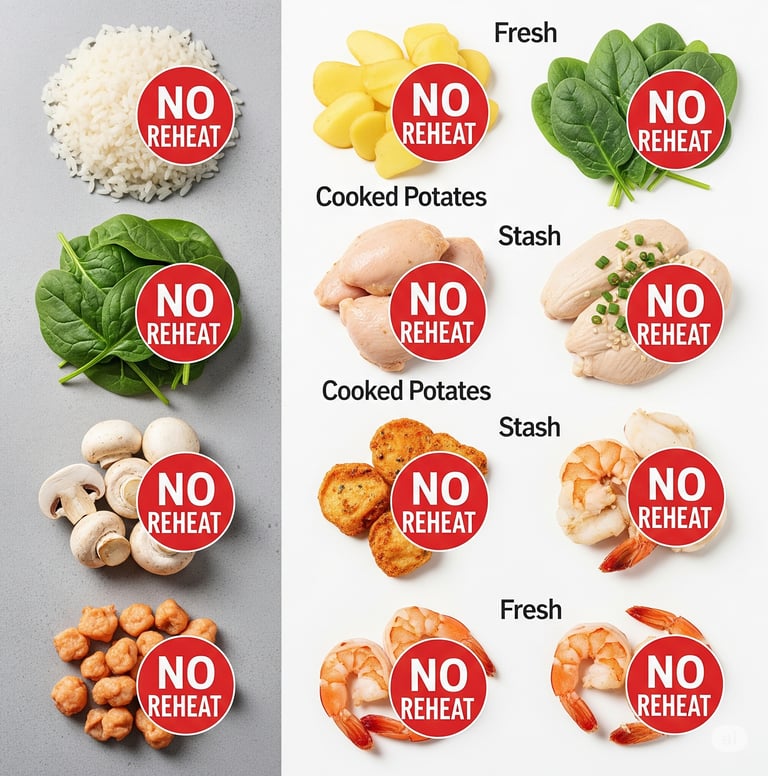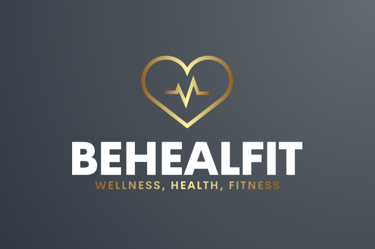Reheat Risk: 7 Foods You Should NEVER Reheat (And Why!)
Learn which 7 foods you should never reheat to avoid food poisoning, nutrient loss, and health risks. Stay safe with these essential kitchen tips!
HEALTHBLOG-LIST
6/25/20257 min read


In Brief
In our busy lives, reheating leftovers is a go-to for convenience. But did you know that some foods can become dangerous or lose their nutritional value when reheated? Reheating certain items can lead to bacterial growth, toxin formation, or a significant loss of beneficial compounds, turning a harmless meal into a potential health risk. This article will reveal 7 common foods you should never reheat and explain the crucial reasons why, helping you keep your kitchen safe and your meals healthy.
Table of Contents
The Hidden Dangers of Reheating Food
7 Foods You Should NEVER Reheat
Rice: The Risky Grain
Cooked Potatoes: A Bacterial Breeding Ground
Chicken: Protein Transformation Trouble
Spinach and Other Leafy Greens: Nitrates to Nitrites
Mushrooms: Digestive Distress
Eggs: Protein Problems
Seafood: High-Risk Health Hazard
Why Reheating These Foods Is Risky: The Science Explained
Testimonial: Sarah's Food Safety Revelation
Safe Reheating Practices: What You CAN Reheat
Tips for Avoiding Food Waste with Risky Foods
Frequently Asked Questions (FAQ) About Reheating Food
Conclusion: Prioritize Safety, Not Just Convenience
1. The Hidden Dangers of Reheating Food
While reheating food seems straightforward, it introduces several risks that can compromise food safety and nutritional quality:
Bacterial Growth: The danger zone for bacterial growth is between 40°F and 140°F (4°C and 60°C). When cooked food cools slowly or is left at room temperature for too long, bacteria like Bacillus cereus (common in rice) can multiply rapidly. Reheating might kill some bacteria, but it doesn't always destroy the toxins they produce, which can cause food poisoning.
Toxin Formation: For certain foods, reheating can change their chemical composition, leading to the formation of harmful compounds like nitrites (from nitrates in vegetables).
Nutrient Loss: Repeated heating can degrade heat-sensitive vitamins (like Vitamin C and some B vitamins) and alter protein structures, diminishing the nutritional value of your meal.
Flavor and Texture Degradation: Beyond safety, reheating often compromises the taste and texture, turning once-appetizing food into something unappealing.
Understanding these risks is key to making informed decisions about your leftovers.
2. 7 Foods You Should NEVER Reheat
Here's a list of common foods that are best consumed fresh or discarded after their initial cooking, rather than risking reheating:
Rice: The Risky Grain
Why avoid reheating: Uncooked rice can contain spores of Bacillus cereus, a bacterium that can survive cooking. If cooked rice is left at room temperature, these spores can multiply and produce toxins that cause vomiting or diarrhea. Reheating won't always destroy these toxins.
Best practice: Serve rice immediately after cooking. If you have leftovers, cool them quickly (within one hour) and refrigerate. Reheat only once, ensuring it's steaming hot throughout, and consume immediately. It's often safer to simply discard rice that has been left out for too long.
Cooked Potatoes: A Bacterial Breeding Ground
Why avoid reheating: Cooked potatoes, especially if wrapped in foil and left to cool slowly at room temperature, can become a breeding ground for Clostridium botulinum, the bacteria that causes botulism. Reheating doesn't always eliminate this toxin.
Best practice: Consume cooked potatoes soon after preparation. If storing, cool quickly and refrigerate promptly. It's generally best to avoid reheating, especially if they weren't cooled properly.
Chicken: Protein Transformation Trouble
Why avoid reheating: Reheating chicken (and other poultry) can alter its protein structure, making it harder to digest and potentially causing stomach upset. If chicken isn't thoroughly reheated to an even temperature throughout, harmful bacteria like Salmonella can also survive.
Best practice: If you must reheat chicken, ensure it's piping hot throughout (above 165°F / 74°C) and only reheat once. Consider using leftover cooked chicken cold in salads or sandwiches.
Spinach and Other Leafy Greens: Nitrates to Nitrites
Why avoid reheating: Leafy greens like spinach, celery, and even beets are rich in nitrates. When reheated, especially in dishes that are cooled slowly or kept warm for a while, these nitrates can convert into nitrites, and then potentially into nitrosamines, which can be carcinogenic.
Best practice: Consume dishes with cooked spinach or leafy greens fresh. If you have leftovers, eat them cold or discard them. Avoid prolonged warming.
Mushrooms: Digestive Distress
Why avoid reheating: Mushrooms contain proteins that can easily degrade after cooking. Reheating them, especially if not stored properly, can lead to digestive upset like stomachaches, bloating, or even more severe reactions.
Best practice: It's best to consume mushrooms immediately after cooking. If you must reheat, ensure they were stored correctly (refrigerated quickly after cooking) and only reheat them once, thoroughly. Even then, caution is advised.
Eggs: Protein Problems
Why avoid reheating: Reheating eggs, particularly scrambled eggs, omelets, or fried eggs that have been sitting out, can lead to the proliferation of Salmonella bacteria if not handled and reheated properly. The protein structure can also become rubbery and unappetizing.
Best practice: Eggs are best eaten fresh. If preparing dishes with eggs, ensure they are cooked thoroughly initially and consume promptly. It's generally safer to avoid reheating egg dishes.
Seafood: High-Risk Health Hazard
Why avoid reheating: Seafood is highly perishable and prone to bacterial growth if not stored and handled correctly. Reheating improperly stored seafood can lead to severe food poisoning (e.g., scombrotoxin poisoning from certain fish).
Best practice: Always consume seafood fresh. If you have leftovers, refrigerate them immediately and consume cold within 24 hours. Reheating seafood is generally not recommended due to the high risk.
3. Why Reheating These Foods Is Risky: The Science Explained
The risks associated with reheating certain foods are rooted in scientific principles:
Bacterial Spore Survival: Bacteria like Bacillus cereus (rice) and Clostridium botulinum (potatoes) produce heat-resistant spores that survive initial cooking. When food cools slowly, these spores germinate into active bacteria, which then multiply and produce heat-stable toxins. Reheating kills the bacteria but not always their toxins.
Nitrate Conversion: In vegetables like spinach and celery, nitrates are naturally occurring. When these vegetables are cooked and then allowed to sit or are repeatedly reheated, bacteria can convert nitrates into nitrites. Nitrites can be harmful, especially for infants, and can potentially form carcinogenic nitrosamines when exposed to high heat.
Protein Denaturation and Degradation: Proteins in chicken, mushrooms, and eggs are sensitive. Reheating can cause further denaturation and breakdown, making them harder to digest for some individuals and creating unpleasant textures. Improper reheating also means bacteria like Salmonella might not be killed.
Perishability of Seafood: Seafood, particularly fish, contains delicate proteins and fats that break down quickly. It's highly susceptible to rapid bacterial growth and histamine production (which can cause scombrotoxin poisoning) if not kept consistently cold. Reheating, especially if inadequate, doesn't mitigate these risks.
4. Testimonial: Sarah's Food Safety Revelation
"I used to reheat everything without a second thought, especially rice and chicken from dinner. I'd occasionally get stomach upset or feel unwell, but I never connected it to reheating. After a particularly bad bout of food poisoning that I suspected came from leftover rice, I did some research and stumbled upon this information. It was a revelation! I learned about the hidden dangers of reheating certain foods and completely changed my habits. Now, I'm much more mindful about what I reheat, and if something's on the 'never reheat' list, it's either eaten fresh or discarded. My digestion has improved, and I haven't had a single food poisoning scare since. It's a small change, but it makes a huge difference in staying safe and healthy!" – Sarah M.
5. Safe Reheating Practices: What You CAN Reheat
While some foods are risky, many can be safely reheated if you follow proper guidelines:
Cool Quickly: After cooking, divide food into smaller portions to cool rapidly (within 1 hour). Refrigerate promptly.
Reheat Thoroughly: Always reheat food until it's steaming hot throughout (at least 165°F / 74°C). Use a food thermometer if unsure.
Reheat Only Once: Avoid reheating food multiple times.
Use Appropriate Methods:
Microwave: Stir food halfway through to ensure even heating.
Stovetop/Oven: Reheat in covered dishes to retain moisture and ensure thorough heating.
Don't Reheat from Slow Cooker/Crock-Pot: Transfer leftovers to a separate container and refrigerate immediately after the food has cooled.
6. Tips for Avoiding Food Waste with Risky Foods
Don't want to just throw away food? Here's how to manage those "never reheat" items:
Cook Smaller Portions: Prepare just enough rice, potatoes, or mushrooms for the meal to minimize leftovers.
Repurpose Cold: Use leftover cooked chicken cold in salads, sandwiches, or wraps. Cooked potatoes can be used cold in potato salads.
Freeze Immediately: If you know you won't eat cooked rice or chicken within 1-2 days, freeze it immediately after cooling properly. When ready to eat, thaw safely and reheat thoroughly once.
Plan Meals: Plan meals around foods that are best eaten fresh or can be repurposed cold.
7. Frequently Asked Questions (FAQ) About Reheating Food
Still have questions about food safety and reheating? Here are clear answers:
Is it safe to reheat food in a microwave? Yes, microwaves are generally safe for reheating, provided the food is heated thoroughly and evenly. Stirring or rotating the food halfway through is crucial to avoid cold spots where bacteria can survive.
How long can cooked food safely sit at room temperature before being refrigerated? The "danger zone" for bacterial growth is between 40°F and 140°F (4°C and 60°C). Cooked food should be refrigerated within 2 hours (or 1 hour if the ambient temperature is above 90°F / 32°C).
Can I reheat food that has been frozen and then thawed? Yes, once food has been safely thawed (in the refrigerator, cold water, or microwave), it can be reheated once. However, you should not refreeze it after reheating.
Does reheating kill all bacteria? While reheating to a high enough temperature (165°F / 74°C) will kill most harmful bacteria, it does not destroy toxins produced by some bacteria (like Bacillus cereus or Clostridium botulinum). This is why proper cooling and storage before reheating are paramount.
What about reheating leftovers from a restaurant? Treat restaurant leftovers with extra caution. They've often been cooked, cooled, and transported. Ensure they are fully cooled and refrigerated promptly. Reheat very thoroughly, and ideally, only once. Seafood leftovers from restaurants are especially risky.
Can I reheat breast milk or baby food? Breast milk should ideally be warmed gently (not reheated) or brought to room temperature. Baby food (purees) can be reheated once, but only the portion that will be consumed immediately. Discard any leftovers from the heated portion.
8. Conclusion: Prioritize Safety, Not Just Convenience
Reheating leftovers is a practical part of modern life, but it's essential to do it safely. By understanding which foods you should never reheat – such as rice, potatoes, chicken, leafy greens, mushrooms, eggs, and seafood – you can significantly reduce your risk of foodborne illness and ensure your meals remain healthy and nutritious. Prioritize quick cooling, thorough reheating (when safe), and smart food management. A little knowledge about food safety goes a long way in protecting your health and the well-being of your family.
